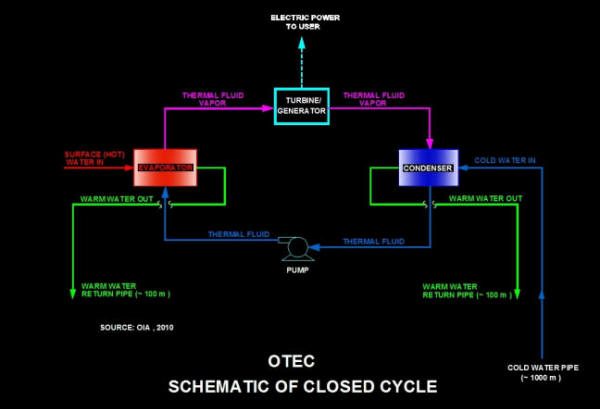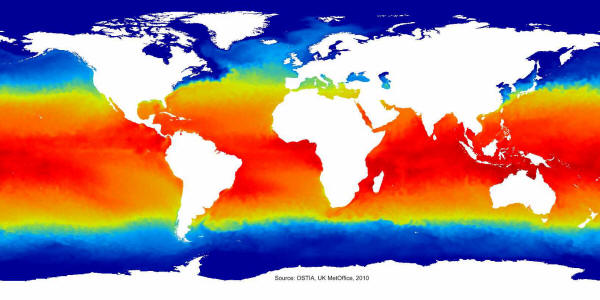
What is OTEC?

Schematic of OTEC Closed Cycle (c) OIA 2010
Ocean thermal energy conversion (OTEC) is a renewable energy technology applicable to tropical and sub-tropical areas that works by recovering solar energy absorbed by the ocean. As opposed to other renewable technologies, such as solar and wind, OTEC is able to generate power on a continuous (baseload) basis. In addition, if desired, OTEC can be used to co-produce potable water through desalination, in addition to electric power. Up to 2 million liters per day (0.5 million gallons per day) can be produced for each megawatt of electricity generated. OTEC will work in areas where the temperature difference between the warmer, top layer of the ocean and the colder, deep ocean water is about 20°C (36°F), in an environment that is stable enough for efficient system operation. The areas highlighted in orange and red in the following picture, taken by the UK Met Office's OSTIA satellite program in February 2010, are those suitable for OTEC.

Heat Content of the Earth's Oceans, source: UK Met Office, 2010
OTEC requires no fuel. Thus, cost of producing electricity and water is not susceptible to the volatility that affects other energy sources such as petroleum, coal and natural gas. Energy is generated from purely local sources at a cost that is essentially fixed and predictable. Further, since no fuels or radioactive materials are used, environmental impacts (including greenhouse gas generation) are much less than those of conventional methods of power generation.
Basic Principles
OTEC plants are heat engines that convert heat into work through the energy gradient between a “source” and a “sink.” This is similar to a steam engine, although in the case of OTEC, the temperature gradient is much smaller. This makes OTEC plants larger than steam plants of comparable capacities.
OTEC has three basic modalities: closed, open and hybrid cycles. In the closed-cycle, the temperature difference is used to vaporize (and condense) a working fluid (e.g. ammonia) to drive a turbine-generator to produce electricity. In the open-cycle, warm surface water is introduced into a vacuum chamber where it is flash-vaporized. This water vapor drives a turbine-generator to generate electricity. Remaining water vapor (essentially distilled water) is condensed using cold sea water. This condensed water can either return back to the ocean or be collected for the production of potable water. The hybrid-cycle combines characteristics of the closed and the open cycles, and has great potential for applications requiring higher efficiencies for the co-production of energy and potable water. In the three cycles, cold ocean water, normally available at depths of 1,000 meters (3,200 feet), where temperature of the water remains constant at around 4 oC (39 oF), is required to condense the working fluid. The illustration at the top of this page shows the closed cycle of OTEC.
Click here to see animated presentations and other graphic material illustrating the concept of OTEC and its potential.
More Information and Copies of Presentations
Presentación Especial en Yabucoa
(c) 2012 Offshore Infrastructure Associates, Inc.